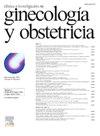Case report of spontaneous hemoperitoneum secondary to uterine myomatosis and adenomyosis
IF 0.1
Q4 OBSTETRICS & GYNECOLOGY
Clinica e Investigacion en Ginecologia y Obstetricia
Pub Date : 2025-09-04
DOI:10.1016/j.gine.2025.101066
引用次数: 0
Abstract
Introduction
Myomatosis and uterine adenomyosis are the most common benign uterine pathologies suffered by women of reproductive age and the symptoms they produce are mainly abnormal vaginal bleeding, dysmenorrhea and pelvic pain, but they are rarely associated with spontaneous peritoneal bleeding. The existence of this entity and its etiology is little known in the literature, limited to case reports, generating a difficulty in diagnosis. The objective of this article is to report an infrequent case of spontaneous hemoperitoneum secondary to uterine myomatosis and adenomyosis.
Main symptoms
Prior informed consent and certification from the institution's ethics committee. This is a 50-year-old Colombian patient, in a state of symptomatic perimenopause with hormone replacement therapy, who came to the emergency department with a history of pain in the lower abdomen of three days of severe intensity, only associated with diarrhea.
Main diagnoses
Abdominal computed tomography and transvaginal ultrasound diagnosed hemoperitoneum associated with a probable left adnexal mass, suggestive of a ruptured hemorrhagic cyst.
Therapeutic interventions and results
Exploratory laparoscopy was performed and identify hemoperitoneum secondary to a highly vascularized subserosal fibroid with bleeding from its base, hypervascularized uterus, without obvious ovarian pathology, associated with multiple adhesions between the fibroid, uterine tube and ipsilateral ovary. Due to the patient's age and continuous uncontrolled bleeding, it was decided to perform a total hysterectomy plus unilateral left salpingo-oferectomy.
Conclusion
This case demonstrates that, although extremely rare, uterine fibroids (still coexisting with adenomyosis) can cause spontaneous hemoperitoneum. It is essential to consider this diagnosis within the acute gynecological abdomen, since timely recognition and treatment improve the prognosis.
子宫肌瘤病继发自发性腹膜出血1例
子宫肌瘤病和子宫血栓是育龄妇女最常见的子宫良性病变,其症状主要为阴道异常出血、痛经和盆腔疼痛,但很少伴有自发性腹膜出血。这种实体的存在及其病因在文献中知之甚少,仅限于病例报告,产生诊断困难。本文的目的是报告一例罕见的自发性腹膜出血继发于子宫肌瘤病和子宫腺肌症。主要症状:事先知情同意并获得机构伦理委员会的认证。这是一名50岁的哥伦比亚患者,处于有症状的围绝经期,接受激素替代治疗,他来到急诊科,有三天的下腹剧烈疼痛史,仅伴有腹泻。主要诊断:腹部计算机断层扫描和经阴道超声诊断腹腔积血可能伴有左附件肿块,提示出血性囊肿破裂。治疗措施及结果:行探查腹腔镜检查,发现浆膜下肌瘤继发于浆膜下肌瘤,其底部出血,子宫血管充血,卵巢无明显病理,肌瘤、输卵管和同侧卵巢之间存在多发粘连。由于患者的年龄和持续不受控制的出血,我们决定进行全子宫切除术加单侧左侧输卵管-子宫切除术。结论本病例表明,虽然极为罕见,但子宫肌瘤(仍与子宫腺肌症共存)可引起自发性腹膜出血。在急腹症中考虑这种诊断是必要的,因为及时识别和治疗可以改善预后。
本文章由计算机程序翻译,如有差异,请以英文原文为准。
求助全文
约1分钟内获得全文
求助全文
来源期刊

Clinica e Investigacion en Ginecologia y Obstetricia
OBSTETRICS & GYNECOLOGY-
CiteScore
0.20
自引率
0.00%
发文量
54
期刊介绍:
Una excelente publicación para mantenerse al día en los temas de máximo interés de la ginecología de vanguardia. Resulta idónea tanto para el especialista en ginecología, como en obstetricia o en pediatría, y está presente en los más prestigiosos índices de referencia en medicina.
 求助内容:
求助内容: 应助结果提醒方式:
应助结果提醒方式:


